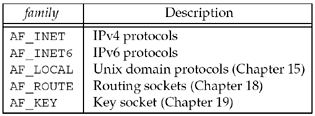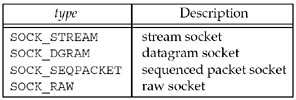4.2 socket Function
To perform network I/O, the first thing a
process must do is call the socket function, specifying
the type of communication protocol desired (TCP using IPv4, UDP
using IPv6, Unix domain stream protocol, etc.).
|
#include <sys/socket.h>
|
|
int socket (int family, int type, int protocol);
|
|
Returns: non-negative descriptor if OK, -1 on
error
|
family
specifies the protocol family and is one of the constants shown in
Figure 4.2. This argument
is often referred to as domain
instead of family. The socket
type is one of the constants shown
in Figure 4.3. The
protocol argument to the
socket function should be set to the specific protocol
type found in Figure 4.4,
or 0 to select the system's default for the given combination of
family and type.



Not all combinations of socket family and type are valid. Figure 4.5 shows the valid combinations, along
with the actual protocols that are valid for each pair. The boxes
marked "Yes" are valid but do not have handy acronyms. The blank
boxes are not supported.

You may also encounter the corresponding
PF_xxx constant as the
first argument to socket. We will say more about this at
the end of this section.
We note that you may encounter AF_UNIX
(the historical Unix name) instead of AF_LOCAL (the POSIX
name), and we will say more about this in Chapter 15.
There are other values for the family and type arguments. For example, 4.4BSD supports
both AF_NS (the Xerox NS protocols, often called XNS) and
AF_ISO (the OSI protocols). Similarly, the type of SOCK_SEQPACKET, a
sequenced-packet socket, is implemented by both the Xerox NS
protocols and the OSI protocols, and we will describe its use with
SCTP in Section 9.2. But,
TCP is a byte stream protocol, and supports only
SOCK_STREAM sockets.
Linux supports a new socket type,
SOCK_PACKET, that provides access to the datalink, similar
to BPF and DLPI in Figure 2.1. We will
say more about this in Chapter 29.
The key socket, AF_KEY, is newer than
the others. It provides support for cryptographic security. Similar
to the way that a routing socket (AF_ROUTE) is an
interface to the kernel's routing table, the key socket is an
interface into the kernel's key table. See Chapter 19 for details.
On success, the socket function returns
a small non-negative integer value, similar to a file descriptor.
We call this a socket descriptor,
or a sockfd. To obtain this socket
descriptor, all we have specified is a protocol family (IPv4, IPv6,
or Unix) and the socket type (stream, datagram, or raw). We have
not yet specified either the local protocol address or the foreign
protocol address.
AF_xxx Versus
PF_xxx
The "AF_" prefix stands for "address
family" and the "PF_" prefix stands for "protocol family."
Historically, the intent was that a single protocol family might
support multiple address families and that the PF_ value
was used to create the socket and the AF_ value was used
in socket address structures. But in actuality, a protocol family
supporting multiple address families has never been supported and
the <sys/socket.h> header defines the PF_
value for a given protocol to be equal to the AF_ value
for that protocol. While there is no guarantee that this equality
between the two will always be true, should anyone change this for
existing protocols, lots of existing code would break. To conform
to existing coding practice, we use only the AF_ constants
in this text, although you may encounter the PF_ value,
mainly in calls to socket.
Looking at 137 programs that call
socket in the BSD/OS 2.1 release shows 143 calls that
specify the AF_ value and only 8 that specify the
PF_ value.
Historically, the reason for the similar sets of
constants with the AF_ and PF_ prefixes goes back
to 4.1cBSD [Lanciani 1996] and a version of the socket
function that predates the one we are describing (which appeared
with 4.2BSD). The 4.1cBSD version of socket took four
arguments, one of which was a pointer to a sockproto
structure. The first member of this structure was named
sp_family and its value was one of the PF_
values. The second member, sp_protocol, was a protocol
number, similar to the third argument to socket today.
Specifying this structure was the only way to specify the protocol
family. Therefore, in this early system, the PF_ values
were used as structure tags to specify the protocol family in the
sockproto structure, and the AF_ values were used
as structure tags to specify the address family in the socket
address structures. The sockproto structure is still in
4.4BSD (pp. 626鈥?27 of TCPv2), but is only used internally by the
kernel. The original definition had the comment "protocol family"
for the sp_family member, but this has been changed to
"address family" in the 4.4BSD source code.
To confuse this difference between the
AF_ and PF_ constants even more, the Berkeley
kernel data structure that contains the value that is compared to
the first argument to socket (the dom_family
member of the domain structure, p. 187 of TCPv2) has the
comment that it contains an AF_ value. But, some of the
domain structures within the kernel are initialized to the
corresponding AF_ value (p. 192 of TCPv2) while others are
initialized to the PF_ value (p. 646 of TCPv2 and p. 229
of TCPv3).
As another historical note, the 4.2BSD man page
for socket, dated July 1983, calls its first argument
af and lists the possible values
as the AF_ constants.
Finally, we note that the POSIX standard
specifies that the first argument to socket be a
PF_ value, and the AF_ value be used for a socket
address structure. But, it then defines only one family value in
the addrinfo structure (Section 11.6),
intended for use in either a call to socket or in a socket
address structure!
|